10 ways the UK's eating habits have changed
- Published
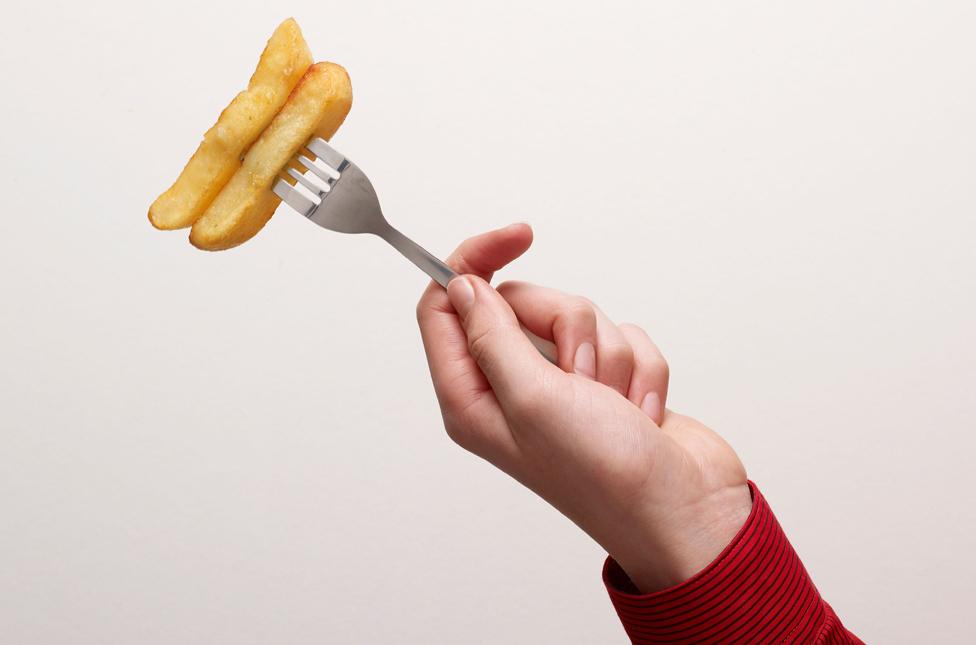
Figures charting the UK's changing food-buying patterns since 1974 have been released. What do they tell us about the nation?
In with chips, fresh fruit and dried pasta. Out with white bread, tinned peas and meat paste. That's the story of the modern British dinner table.
Data from 150,000 households who took part in the survey of their food and drink habits from 1974-2000 has been published by the Department for Environment, Food and Rural Affairs (Defra).
It comes from the National Food Survey, which in 1940 began asking households to fill out diaries of their weekly food and drink purchases.
Together with studies that replaced it from 2000, the survey data offers a fascinating snapshot of the nation's shifting norms of dining and imbibing. So what does it reveal?
Less white bread, less full-fat milk
Purchases of white bread have dropped 75% since 1974, according to the survey, while those of brown and wholemeal bread have risen by 85%. Skimmed milk (referring both to skimmed and semi-skimmed) overtook whole-fat milk in the 1990s and British households now drink four times as much.
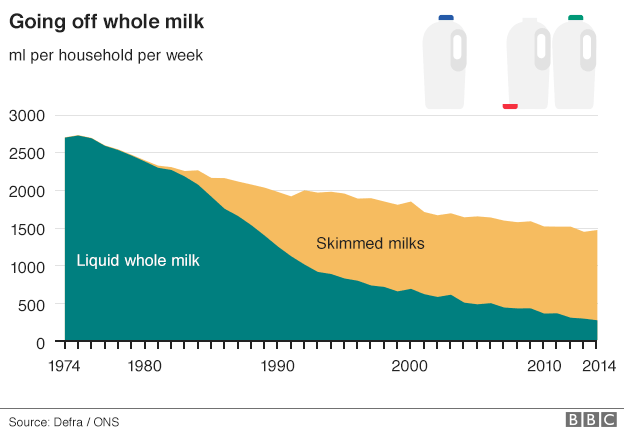
All of this reflects public health advice issued over the period. "Switching to skimmed milk was heavily promoted in the late 1990s as part of a focus on heart health and cholesterol levels," says Emma Jayne Abbots, lecturer in social and cultural anthropology and heritage at University of Wales Trinity St Davids. "It wouldn't have been due to cost as full fat is the same price."
It would appear that this was an example of a public health campaign working - even if some of the advice around fats and cholesterol has more recently been called into question.
Meanwhile, fresh fruit purchases went up nearly 50% while that of "soft drinks, not low calorie" dropped by a third. "It seems we do have healthier eating habits and diet is not as much of an issue as public health officials would have us believe," says Abbots.

The fall of liver
People used to really like eating liver. In 1974 a typical household bought 36g of it per week.
But not by 2014. Then the figure had fallen to just 3g - a 92% drop. Offal - familiar to a wartime generation that eschewed waste - had fallen out of favour among younger, more squeamish Britons.
"People don't know what to do with offal any more," says Annie Gray, resident food historian on BBC Radio 4's The Kitchen Cabinet. The resurgence of so-called "nose-to-tail" cooking in certain high-end restaurants appears not to have had much influence in the mass market, she adds.
Other meats have fared differently. Pork and mutton also saw more modest falls in popularity, while consumption of uncooked chicken and minced beef rose 62% and 35% over the same period respectively.
The Italianisation of British meals

Italian-style cooking is widespread today. But dried and fresh pasta was not even recorded on the National Food Survey until 1998. Between then and 2014, weekly household purchases in this category more than doubled.
Pizza (frozen and not frozen) rose even more dramatically, with average purchase from 2g per week in 1975 to 53g in 2014. The amount of takeaway pizzas bought per household shot up 1,000% over the same period.
It's not as though the UK was new to Italian cooking in the early 1970s, says Gray. Macaroni was a common fixture in Victorian cookbooks, she says, but wartime appears to have disrupted the advance of pasta.
The growth of pizza has a different dynamic, she says, in that it "comes out of Italy but it's popularised by Americans". Indeed, Defra statisticians have mapped the growth of pizza against the popularity of the Teenage Mutant Ninja Turtles in the 1980s.
Cheaper food
It might not always feel like it as you stand at the till, but doing the weekly shop has become more affordable over time.
According to the data, some 24% of a typical pay packet went on food in 1974 compared with 11% today.
This reflects a broader trend, says Gray. "Right up to the 1950s, we spent a third of our income on food," she says. Increased competition, better logistics and modern agricultural methods have all played a part in this.
However, falling prices have sometimes meant a drop in quality of some products at the bottom end of the market too, says Gray: "There comes a point where food doesn't get any cheaper without corners being cut."
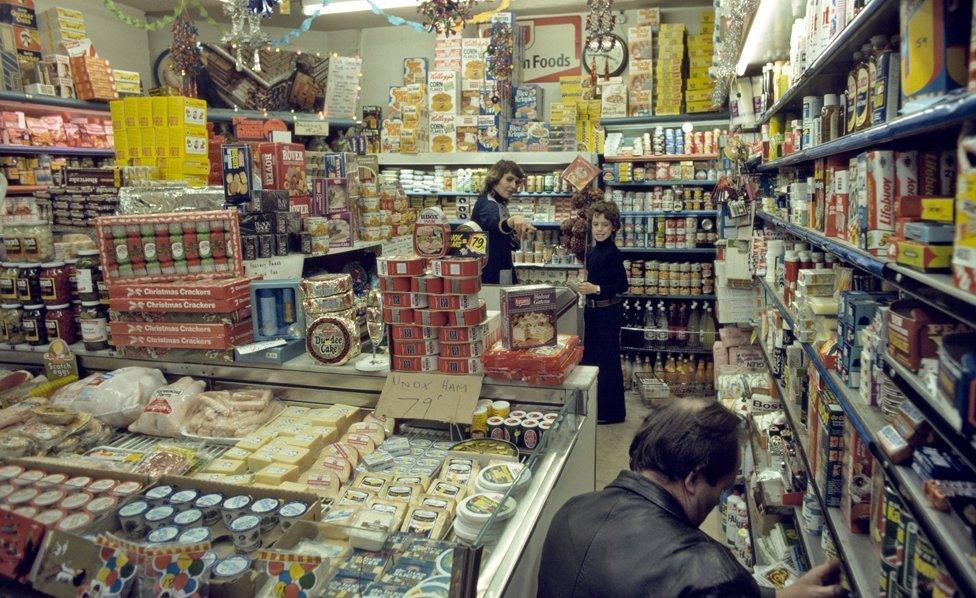
Freezer revolution
According to the survey, just 15% of households owned a freezer in 1974. By 2000 that figure stood at 94%.
This is matched by a drop in the popularity of canned and tinned food. The amount of canned peas bought by a typical household dropped from 88g to 14g per week between 1974 and 2014. In total, consumption of canned vegetables dropped by a third over the same period.
Meanwhile, "ready meals and convenience meat products" went up fivefold.
Decline of tea

Surprising though it may appear to inhabitants of any workplace where tea runs remain an integral part of the daily routine, consumption of the UK's preferred hot drink has declined steadily since 1974.
Back then, the average household bought 68g per week. By 2014 that had fallen to 25g. While tea remained more popular than instant coffee, cocoa and malted drinks, its reported weekly purchases had experienced almost a two-thirds fall.
Abbots says this "may be because of the emergence of a coffee culture in the UK". It's also been suggested, external that the rise of speciality and flavoured teas, and a decline in popularity of sweet biscuits, may have played a part.
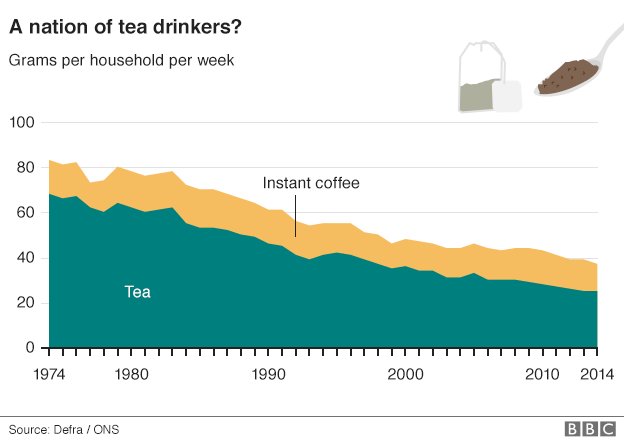
More chips
The nation's preferred form of potato remains the chip.
Reported purchases in the category "chips (frozen and not frozen)" were three times higher in 2014 than in 1974. In a blow to the chip shop industry, however, households reported buying a third less takeaway chips over the same period.
Over this period, brands pushed the notion that oven chips were both a treat and a shortcut, says Gray. "They are very aggressively marketed," she adds. "Convenience foods are driven by perceived lack of time and perceived ease of cooking," she adds.

Timeline of the National Food Survey
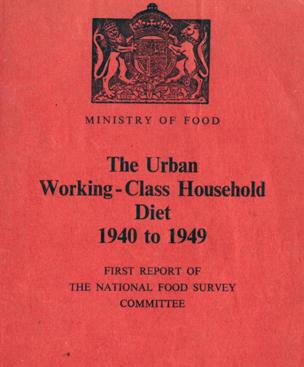
The National Food Survey was established in 1940, and looked at the household eating habits of the urban working class
In 1950 the survey was extended to be a national sample of Great Britain
Northern Ireland was added to the survey in 1991
The National Food Survey merged with the ONS Family Expenditure Survey in 2001 to create the Expenditure and Food Survey, and it was renamed the Living Costs and Food Survey in 2008
Source: DEFRA

Different fish
The traditional accompaniment to chips has fared differently. A typical household bought 44g of white fish (fresh, chilled or frozen) per week in 1974. While it still remained the most popular fish choice, 40 years later that figure was just 19g.
But other types of seafood did better. Shellfish purchases rose fivefold, and those of salmon by 550%.
"I think health marketing around the benefits of omega 3 as well as the decline in price explains the increase in salmon consumption," says Abbots. At the same time, despite anxieties about stocks of white fish like cod and haddock, "the British public aren't great at trying different white fish substitutes that they haven't heard of".
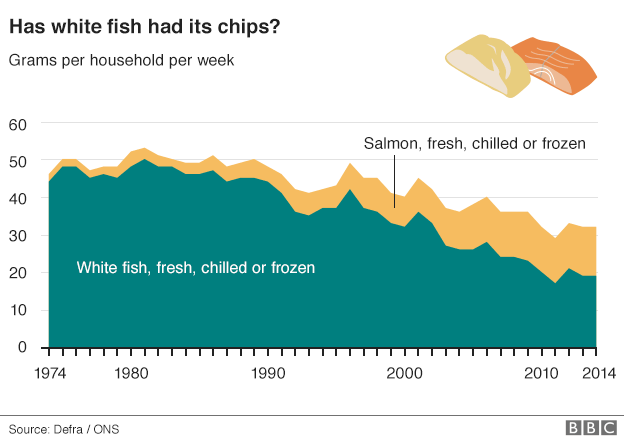
The role of women
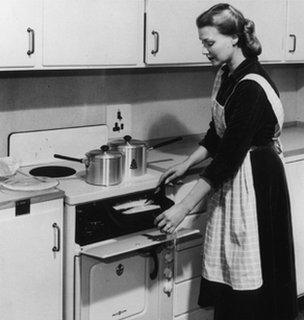
In 1991 the survey stopped asking the "housewife", to fill out its questionnaire. The respondent was later renamed the "main diary keeper".
"That's really late for that to happen, isn't it?", asks Gray rhetorically.
But although terminology that today would be considered sexist has been dispensed with, society hasn't quite caught up yet with decades of demands for equality, she says. Surveys suggest, external that British women still remain chiefly responsible for food shopping duties.
Not in one basket
Providing your own eggs may have been part of the Good Life envisioned by many late-20th Century householders. But the survey stopped asking people if they had access to their own eggs, or if they owned hens, ducks or geese, in 1991. It still asks about "home grown" food, which could include eggs, but there's not a specific question on them.
Abbots says the decline of this practice - popularised in wartime out of necessity - was probably due to urbanisation: "I'm actually surprised they changed the survey question as late as 1991."
But over the next decade she expects to see an increase in sourcing one's own eggs rather than relying on supermarkets. "My own research has found a huge increase in communal gardens, with long waiting lists for allotments," she says.
This may have been accelerated by austerity in the wake of the credit crunch, she says. But more recently "it seems to be driven partly by necessity, and partly opting out of the industrial food system".
Follow Jon Kelly on Twitter @mrjonkelly, external
Subscribe to the BBC News Magazine's email newsletter to get articles sent to your inbox.